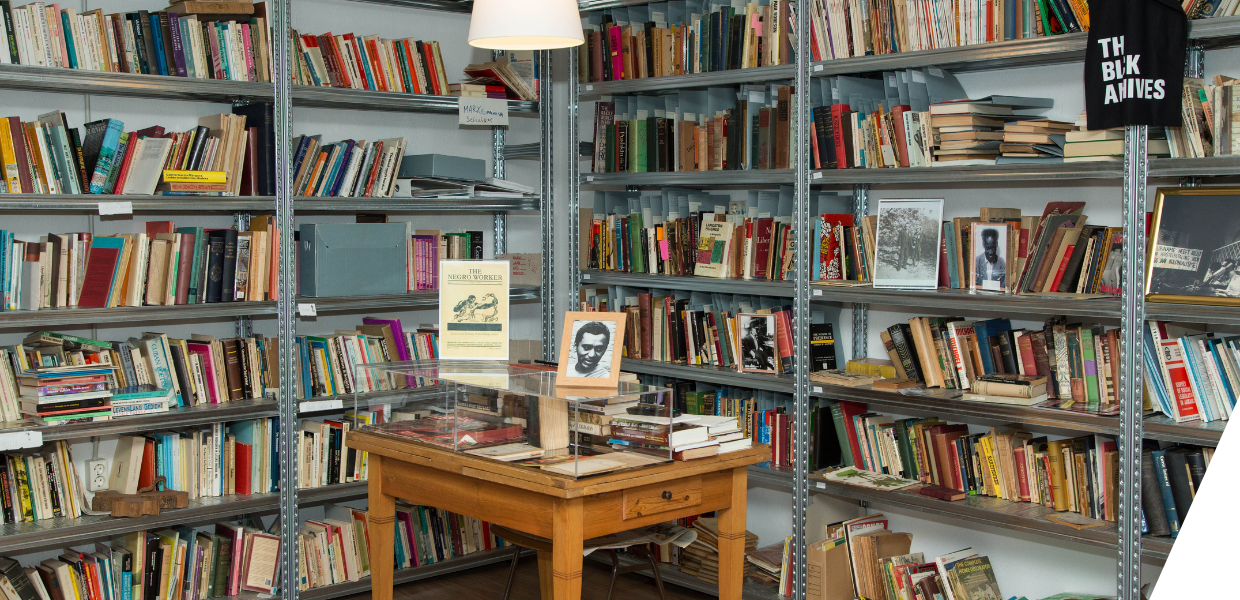Thank you so much for speaking to us! What can you tell us about the history of the Black Archives?
Based in Amsterdam, The Black Archives is a historical archive with a unique collection of books, documents, photographs, audiovisual material and artifacts, which are the legacy of Black Dutch writers, scientists and activists. It documents the history of Black emancipation movements and individuals in the Netherlands. Currently, the archive consists of more than 10,000 items about the history of people of Surinamese or African descent in the Netherlands.
We aim to inspire conversations, activities and literature from Black and other perspectives that are often overlooked elsewhere. The collections are intended as a starting point that can grow through donations and collaborations with others. In this way, Black literature, knowledge and information is made accessible for study and research. Based on these collections, we develop exhibitions, public programmes and other educational activities to share hidden and forgotten histories.
For us, it is necessary to make Black (Dutch) history visible, as we want to share it from our perspective in a non-Eurocentric way. Our history is almost always written without us, rarely with us.
What projects are you currently focusing on?
At The Black Archives, we work on archiving, community work and social justice through various activities. Besides archiving, we use educational events and art as a way to share our findings and information. Currently, we are working on our exhibition ‘Facing Blackness’ to reflect on 10 years of peaceful demonstrations during the anti-zwarte piet movement which started in 2011. In our current anti-racism movement, the blackface character zwarte piet (‘Black Pete’) serves as a symbol in the fight against institutional racism in the Netherlands. We wanted to place the racist figure in a historical context of colonial imagery that has been (and still is) circulating in our societies for many centuries. Alongside our focus on racial imagery produced in the Netherlands and in other European countries, we will show the long tradition of resistance against zwarte piet and racism in the Netherlands, which is often forgotten.
Does digital technology, practices or engagement have a role in this work? What challenges have you encountered finding, highlighting and digitising Black cultural heritage?
Definitely! Digital technology is key to conversations among archivists on how to sustainably archive cultural heritage. While The Black Archives has a physical space within the Surinamese historical building of Vereniging Ons Suriname (Association Our Suriname), which celebrated its 100th anniversary in 2019, our collections are not completely digitised yet. Our biggest challenge is funding - archiving and digitising is another expensive component. However, we are aiming to digitise our collections to share hidden, forgotten and silenced histories from non-western perspectives.
Can you give us an example of a digital project you have worked on?
We digitised many of the protest signs left by protesters during the 2020’s Black Lives Matter demonstrations across the Netherlands. An online collection of these signs was established shortly after to archive an important moment in history and memorialise the protests and their wider socio-political contexts of 2020. The collection has a grassroots and community-based approach - people can make suggestions or corrections. On the same website, visitors are also able to search through and add donations of racist memorabilia and find more archived objects. This helps us to recognise how everyday items produce colonial structures. In order to execute an archiving project that is accessible and community-based, funding is crucial but still challenging. Explore the collection.
From your perspective, what is the importance of digitising these materials in the Black Archives Amsterdam?
We want to make our histories available to our own community as well as wider society. From a young age, we noticed that we barely learned about what brought Surinamese (and other) communities to the Netherlands (from a critical perspective) in schools and universities. There is a large misunderstanding that migration and travelling was a one-way process and a phenomenon that is quite recent. However, there is a larger migration history between Europe and the rest of the world which involved colonialism, trade and oppression. We must know about the past to understand our current societies. Methods such as digitising help us to share knowledge and information, and have a better conversation about these topics.
Have you also found that there is a disproportionate acknowledgment of Black women’s achievements and history represented in collections? If so, why do you think that is and have you also struggled with this in your collections?
In conversations on social justice and racism, we often forget how Black people and people of colour also experience multiple forms of discrimination such as transphobia, heterosexism and sexism, for instance. This translates into Black (trans/queer) women being ‘double (triple and more)’ silenced in various communities (see Claudia Jones’ theory of triple oppression). Given the hierarchical and social orders of current societies, even our archives are not immune to such structures.
However, if we don’t acknowledge the problem, there is no room to come up with solutions. At The Black Archives it is important to us to acknowledge that Black communities and communities of colour are rich in diversity, culture and intellectuality.
What steps can cultural heritage institutions take to acknowledge, surface and highlight Black history in their own collections?
If we don’t acknowledge the problem, there is no room for solutions. As cultural heritage institutions, it is important to understand that diverse organisations, teams, and collections provide a healthier and safer society for all. Changes must be structural, and structural changes need financial support. Within European countries, finances are often not a problem, but rather what we give priority to. Diversity is still much seen as a burden, rather than a long-term investment to make a better world.

